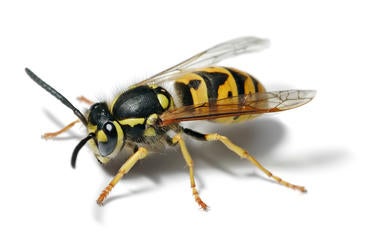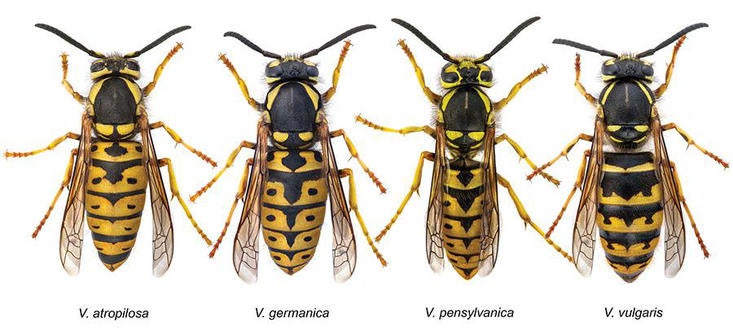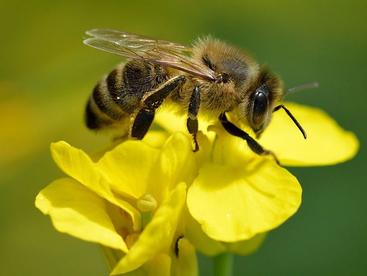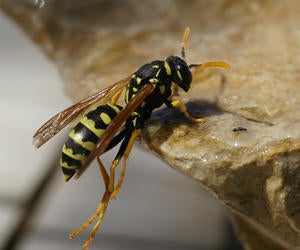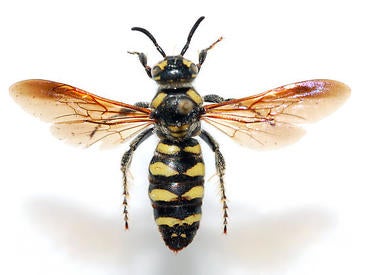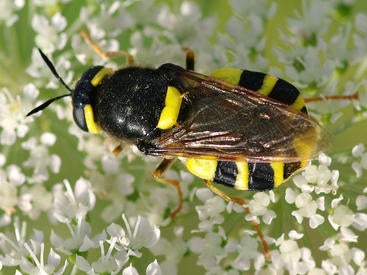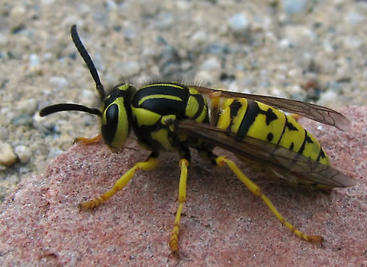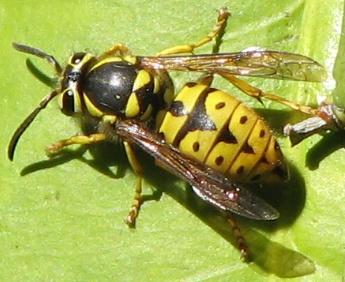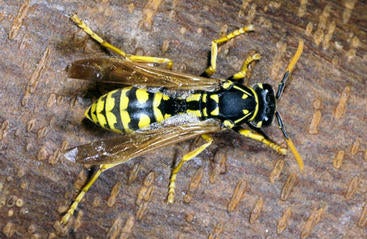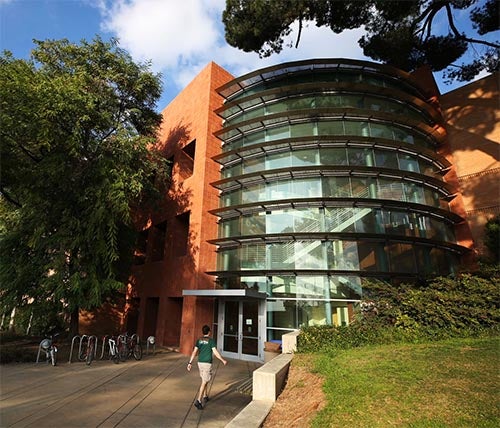Identification Guide for Southern California Yellowjackets
prepared by Rick Vetter, Entomology, UC Riverside
As of the summer of 2002, entomologists at University of California-Riverside are embarking on a 3-year study to document the distribution of the German yellowjacket in southern California and develop a control program involving environmentally safe baits. The first part of the study entails determining exactly where the German yellowjacket and our native species live. The wasp to the right is a German yellowjacket wasp.
History
In southern California, the most widespread yellowjacket has historically been the native, western yellowjacket, Vespula pensylvanica. The German yellowjacket, V. germanica, became established in the Northeastern U.S. in the 1970s and then the Pacific Northwest in the 1980s where it spread down the coast. It reached southern California in 1991 becoming part of our fauna. There are other Vespula species as well but they are not nearly as common in urban southern California, and they are not considered to be pests.
Species differences
Yellowjackets are adapted for temperate climates so therefore, you find more species in the northern than southern United States and more in northern California in comparison to southern California. There are differences among the yellowjacket groups that translate directly into whether a particular species is an urban pest yellowjacket.
First, the non-pest yellowjackets. In the western U.S., yellowjackets belong to either the genus Dolichovespula or Vespula. Within the Vespula species, there are several groups, most notably, the Vespula rufa group and the Vespula vulgaris group. The Dolichovespula wasps and those of the Vespula rufa group are strictly insectivorous. What this means to humans is that they are beneficial wasps because they eat many disease-spreading or crop-eating insects like flies, caterpillars, grasshoppers, etc. that are detrimental to humans. These insectivorous wasps ARE NOT scavengers for meat and, therefore, they are not pests at our picnics, outdoor receptions, campgrounds, etc. There are several species of these wasps in southern California (Dolichovespula arenaria in the mountains, V. sulphurea, the California yellowjacket in the mountains and foothills, V. atropilosa, a montane species, and north of Santa Barbara, one might find V. consobrina). These wasps typically make small colonies with only a few hundred wasps at peak population and the nests typically die out by the end of summer. These wasps may occasionally seek out sweets from our sodas and fruits, however, most of the time, they leave humans and their food alone and they rarely show up in yellowjacket traps.
In contrast, the pestiferous wasps are members of the Vespula vulgaris group, which have nests with peak wasp population numbering in the several thousands and they continue their life cycle well into the late autumn. Although they do collect insect prey, they also scavenge meat which puts them into contact and conflict with humans. These are the wasps which harass us at outdoor eateries, theme parks, receptions and picnics, congregate at bakeries or candy factories, seek out spilled sodas at sporting stadiums, etc. Basically, their scavenger behavior puts them into interaction with humans which increases the potential for sting incidents as well as being a nuisance which could curtail or cancel outdoor activities. In southern California, there are two species representing the V. vulgarisgroup, the western yellowjacket, V. pensylvanica and the German yellowjacket, V. germanica.
There are subtle behavioral differences between the western and German yellowjackets. The western yellowjacket appears to nest predominantly in hilly areas and makes its nest in the ground in abandoned rodent burrows. Therefore, one typically finds the western yellowjacket around natural areas, in foothills and such and rarely finds them in the middle of urbanized regions. In contrast, the German yellowjacket typically makes nests off the ground and hence, uses wall voids and cavities in places like palm trees that are covered by fronds. Because of their association with homes, German yellowjackets are found in urban areas where previously, yellowjackets had been absent for years. Because areas of southern California differ so markedly, we are attempting to determine how the population composition of the two yellowjacket species changes as one moves through Los Angeles.
It is important to know where each species is dominant because there are species differences in food preferences which could be important in the development of control measures. These food preferences would be fine-tuned in order to maximize control efficiency, using the best bait for the specific species.
How to identify yellowjackets
Yellowjackets are amazingly easy to identify to species. Most of the time in entomology, if you try to identify an insect to species you must dissect out some very obscure body part and compare it to some arcane illustration. With southern Californian yellowjackets, you use coloration and markings that you can see most often without a magnifying lens. First of all, you need to know that you have yellowjackets because despite what may seem very simple, many people still mistake other flying insects as yellowjackets.
Not a yellowjacket
Honey bees (right) are mustard yellow and brown and are covered with many hairs to which pollen adheres. They have stocky bodies. Honey bees harvest nectar (carbohydrates) and pollen (protein) from flowers and NEVER are attracted to meats.
Paper wasps (left) are often mistakenly called yellowjackets by the non-entomologist. These wasps are much longer in body and have a very thin "wasp-like" waist. They make nests under the eaves of houses, in bushes, in empty boxes and garden pots, etc. These nests are relatively small, consist of only one layer of comb for brood rearing and are never covered with a paper envelope (that is, when you look at the nest, you can see the wasps and the comb; yellowjacket nests are covered with a paper envelope). Paper wasp nests only reach a colony size of about 100 wasps. Paper wasps are brown and yellow whereas yellowjackets are usually black and yellow.
There are many other insects that mimic yellowjackets. These include flies (e.g. the stratomyid below), moths, and other wasps (eg the scoliid, right) This mimicry gains them protection from predators who avoid them thinking that if they attacked one, they would get a nasty sting.
Identification of southern California yellowjackets in the Los Angeles Basin
Southern California yellowjackets are black and yellow (one species, V. consobrina is black and white but is found north of the LA basin) and typically are rather smooth (not hairy) in appearance. Some people think that they are bees because they have stocky bodies like honey bees. The fact that one of their common names is "meat bees" doesn't help to defray the confusion. Almost every yellowjacket that you will collect will either be a western or German yellowjacket but included here is one other just in case you run into it.
Does the wasp have two longitudinal bands on its thorax (2nd body part) like the wasp on the far right?
- if yes, it is the California yellowjacket, V. sulphurea
- if no, continue to the next step
When looking straight down on the wasp's head, are there yellow rings completely encircling the eyes?
if yes, it is the western yellowjacket, V. pensylvanica. (There will also be a yellow blotch of pigment on the first antennal segment.)
- if no, continue to the next step
When looking straight down on the wasp's head, is the yellow ring broken up around the eyes?
-
if yes, it is the German yellowjacket, V. germanica. (Also, the first antennal segment will be completely black).
-
if no, either you don't have a yellowjacket, you have a male yellowjacket, or you have a species not considered here.
A subtle point: the coloration of the abdomen is often a soft lemony yellow in the native western yellowjacket while it is brighter "school bus" yellow in V. germanica.
Contact information:
Entomology Bldg.
General Info: (951) 827-5714
Fax: (951) 827-3086
Dept. Chair: (951) 827-7250

